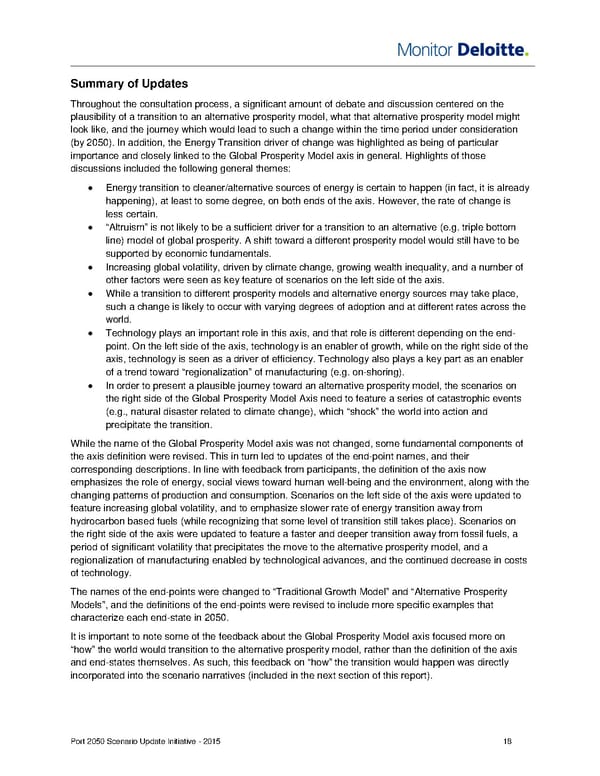Summary of Updates Throughout the consultation process, a significant amount of debate and discussion centered on the plausibility of a transition to an alternative prosperity model, what that alternative prosperity model might look like, and the journey which would lead to such a change within the time period under consideration (by 2050). In addition, the Energy Transition driver of change was highlighted as being of particular importance and closely linked to the Global Prosperity Model axis in general. Highlights of those discussions included the following general themes: • Energy transition to cleaner/alternative sources of energy is certain to happen (in fact, it is already happening), at least to some degree, on both ends of the axis. However, the rate of change is less certain. • “Altruism” is not likely to be a sufficient driver for a transition to an alternative (e.g. triple bottom line) model of global prosperity. A shift toward a different prosperity model would still have to be supported by economic fundamentals. • Increasing global volatility, driven by climate change, growing wealth inequality, and a number of other factors were seen as key feature of scenarios on the left side of the axis. • While a transition to different prosperity models and alternative energy sources may take place, such a change is likely to occur with varying degrees of adoption and at different rates across the world. • Technology plays an important role in this axis, and that role is different depending on the end- point. On the left side of the axis, technology is an enabler of growth, while on the right side of the axis, technology is seen as a driver of efficiency. Technology also plays a key part as an enabler of a trend toward “regionalization” of manufacturing (e.g. on-shoring). • In order to present a plausible journey toward an alternative prosperity model, the scenarios on the right side of the Global Prosperity Model Axis need to feature a series of catastrophic events (e.g., natural disaster related to climate change), which “shock” the world into action and precipitate the transition. While the name of the Global Prosperity Model axis was not changed, some fundamental components of the axis definition were revised. This in turn led to updates of the end-point names, and their corresponding descriptions. In line with feedback from participants, the definition of the axis now emphasizes the role of energy, social views toward human well-being and the environment, along with the changing patterns of production and consumption. Scenarios on the left side of the axis were updated to feature increasing global volatility, and to emphasize slower rate of energy transition away from hydrocarbon based fuels (while recognizing that some level of transition still takes place). Scenarios on the right side of the axis were updated to feature a faster and deeper transition away from fossil fuels, a period of significant volatility that precipitates the move to the alternative prosperity model, and a regionalization of manufacturing enabled by technological advances, and the continued decrease in costs of technology. The names of the end-points were changed to “Traditional Growth Model” and “Alternative Prosperity Models”, and the definitions of the end-points were revised to include more specific examples that characterize each end-state in 2050. It is important to note some of the feedback about the Global Prosperity Model axis focused more on “how” the world would transition to the alternative prosperity model, rather than the definition of the axis and end-states themselves. As such, this feedback on “how” the transition would happen was directly incorporated into the scenario narratives (included in the next section of this report). Port 2050 Scenario Update Initiative - 2015 18
 Monitor Deloitte - Final Report Page 19 Page 21
Monitor Deloitte - Final Report Page 19 Page 21